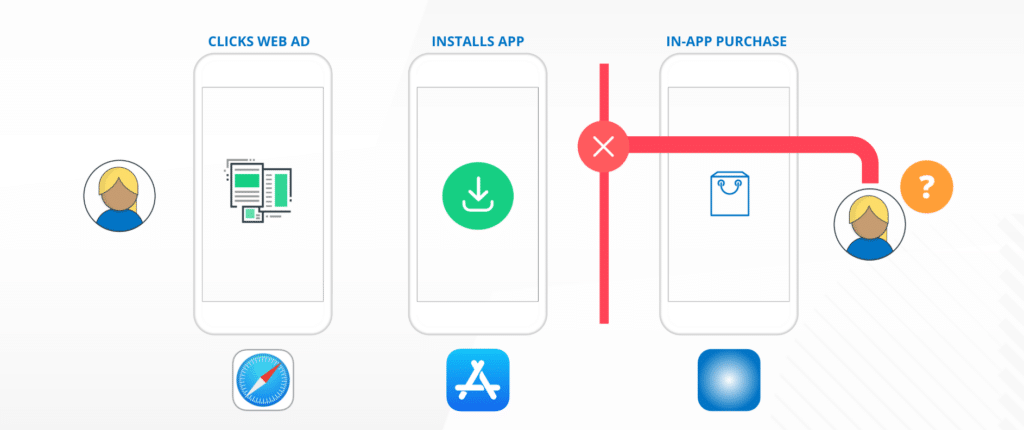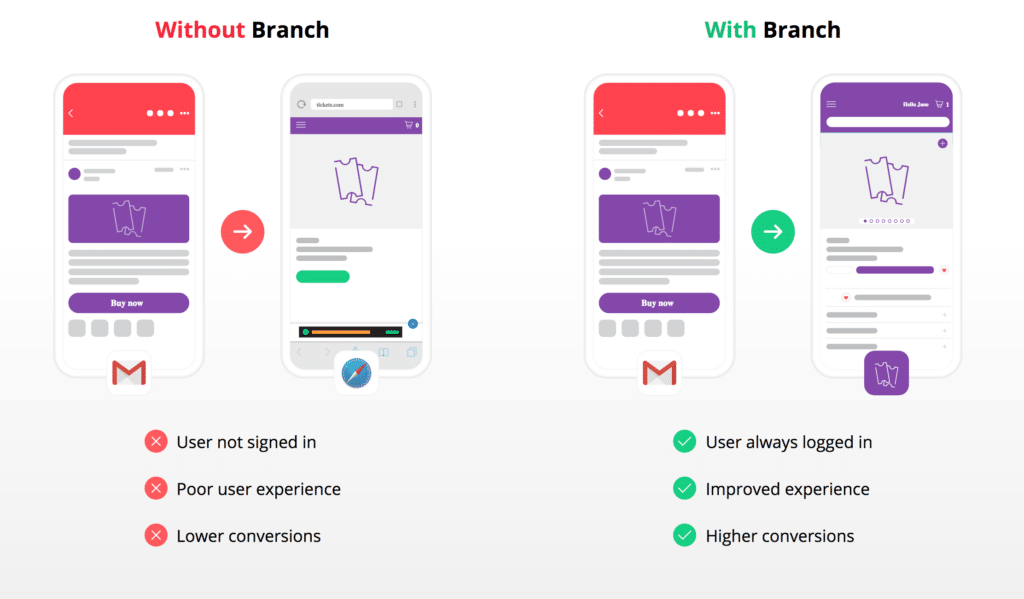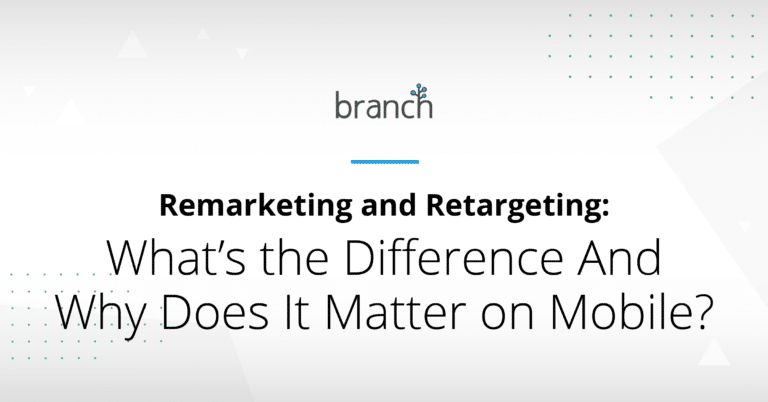Marketers and their teams are facing more challenges than ever when it comes to remarketing and retargeting their mobile users to drive continued app revenue and engagement.
Users are largely mobile, and marketing teams that focus on desktop-only remarketing and retargeting are leaving money on the table.
What Is The Difference Between Mobile Remarketing and Retargeting?
These two terms are so similar that it’s easy to get them confused – especially if you’re new to marketing. (Seasoned marketing vet? Feel free to skip ahead to the next section.)
Mobile Retargeting refers to serving personalized display ads to a user to drive clicks. On mobile, these ads are often used to drive users back into the app as a growth strategy.
Retargeting is more difficult on mobile, as the cookies we rely on in the desktop experience don’t work across the many devices and platforms that are offered to users. To solve for this challenge, iOS created Apple Identifier (IDFA) and Android created GAID (Google Advertising ID). These two unique IDs are similar to cookies, in that they allow advertisers to identify unique users, and determine whether a user has completed an action (install, click, conversion, etc.).
Mobile Remarketing typically refers to using email to re-engage users who provide their contact information to your company via a web form. In this example, users might be dropped into an email nurture that encourages them to re-engage with a brand, or be sent offers that drive them back into the app.
Remarketing also comes with its challenges on mobile: Specifically, offering users a seamless path from email to install or email to app can be complicated – and a broken journey results in lost users, downloads, and conversions. Simply put, if users are stranded along the path from email to app, ROI suffers.
So how can you make sure your retargeting and remarketing efforts are paying off in app growth and revenue? Let’s take a look at some keys to success.
Mobile Retargeting: Keys to Success
Retargeting ads can occur in a number of places on mobile, including on the mobile web and within apps.
These mobile ads are meant as a way to drive users back into an app, where they are likely to spend up to 3x more than in other channels. A few more stats to consider:
- 53% of paid clicks occur on mobile devices, according to SEO Tribunal
- Appearing in mobile search ads results can increase brand awareness by 46%, according to Google
- Visitors retargeted with ads are 70% more likely to convert, according to SEO Tribunal
The challenge: In the cookie-less mobile environment, companies need surefire ways to recognize and respond to users’ interests, then serve relevant retargeting ads that ensure users are driven into the app.
Let’s take a look at how that might work – and where the journey goes wrong.

Legacy attribution providers can’t go beyond last-click measurement, making it impossible to track the performance of your paid ads from click to install to conversion.
In the example above, a user on the mobile web clicks a paid ad that’s meant to drive the user into the app store. But if this user goes on to complete an in-app purchase, legacy attribution providers will fail to connect that down-funnel conversion with the ad that appealed to the user before.
Here’s why: Retargeting on mobile requires the ability for marketing teams to run ads that are attributable from first-click to install to conversion.
One way to do that: Branch’s Universal Ads. Deep-linked and attributable throughout the user journey, Universal Ads drives higher mobile retargeting ad performance for today’s top brands – simply by seamlessly routing users from ads to the right in-app content or offer at the right time.
Let’s look at how this worked for Checkout 51, one of the world’s leading rebate apps for grocery store cashback and rewards.
Checkout 51 knew that mobile retargeting was a critical way to re-engage users who already had the app installed. But the company noticed its paid ads weren’t performing as well as they should – especially given the rising costs for the saturated ad market.
It turned out users who clicked on the retargeting ads were being delivered to the app store – even if they had the app installed. Using Branch’s Universal Ads, Checkout 51 was able to determine which users had the app installed – and instead deliver them from paid ads to the right in-app content at the right time. Even better, Branch’s links were able to automatically apply the relevant offer from the paid ad during checkout, so users didn’t have to manually input a promo code.
Users benefited from a frictionless checkout in-app, and were more likely to convert – and they did. Checkout 51 saw click-to-open rates increase from 50% to 93% in just one month. (Find out more by reading the Checkout 51 Case Study.)
Bottom line: Deep linking your retargeting ads to ensure your users land in the right place within your app to easily convert is critical to driving retargeting ROI.
Now, let’s take a look at how to drive more revenue from your email remarketing efforts.
Mobile Remarketing: Keys to Success
Before we dive into how to make emails work harder for you on mobile, let’s take a look at the state of email today.
- 91% of consumers check their email daily, according to Campaign Monitor
- Roughly 70% of emails are opened on mobile devices, according to Campaign Monitor
- 4.24% of visitors from email marketing make a purchase, compared to 2.49% of visitors from search engines and 0.59% from social media, according to Monetate
As the numbers show – email isn’t going anywhere, and it’s increasingly a mobile space. But that doesn’t mean getting your emails to perform their best on mobile is easy.
Here’s the challenge: Driving users to the mobile web often creates a broken experience. Since mobile websites can’t automatically log users in, there are multiple friction points on an email-to-mobile-web journey that can lead to a user bouncing instead of buying.
We already know it’s important for our emails to be short, beautifully designed, and full of relevant offers that will make the end user click. But if they’re lost on the mobile web post-click, it’s likely the conversion is already lost.
One solution: Branch’s Universal Email, which deep links users from email into the app, carrying the users’ context and offers with them.
Here’s an example of how that flow works without deep linking compared to how the experience works with deep linking.

In the example above, two distinct web-to-app user flows are shown: One without deep linking and one web-to-experience with deep linking.
Strava, one of the world’s leading apps for runners, noticed its users were being routed to the mobile web whenever they clicked on a link within an email.
Knowing how crucial it is to land these users within the app where they were more likely to engage, Strava turned to Branch’s Universal Email. By driving users directly from a promotional email into the app, Strava saw over 40% of email clicks result in app engagement. (Find out more by reading the full case study.)
Those results are consistent with the ROI we’ve seen generated by today’s top ecommerce brands, too.
While it’s easy to mix up remarketing and retargeting if you’re just starting out, there’s no doubt that both strategies can be improved with sophisticated technologies that ensure users receive a seamless experience from any channel into the app.
Ready to find out how Branch can help drive your mobile growth with deep linking – and enable you to accurately attribute your marketing efforts beyond last-click? Contact our sales team today.






















